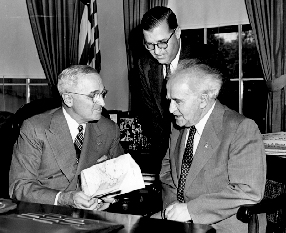David Ben-Gurion
|
|
Dben-gurion.jpg
David Ben-Gurion (October 16, 1886 – December 1, 1973; Hebrew: דָּוִד בֶּן גּוּרִיּוֹן) was the first Prime Minister of Israel.
| Contents |
Early life
Paula_and_David_Ben_Gurion_1915.jpg
He was born as David Gruen (pronounced "Green") in Płońsk, Poland which was then part of the Russian Empire. Shocked by the pogroms and rampant anti-Semitism that plagued Jewish life in Eastern Europe, he became an ardent Zionist and socialist and moved to Palestine in 1906.
He first worked as a journalist and adopted his Hebrew name Ben-Gurion as he began his political career. He was expelled from Palestine, then under the rule of the Ottoman Empire, in 1915 due to his political activities.
Settling in New York City in 1915 he met the Russian-born Paula Munweis. They were married in 1917, and subsequently had three children. The family returned to Palestine after World War I after it had been conquered by the British.
1918_Private_BenGurion_volunteer_in_Jewish_Legion.jpg
Zionist leadership
Ben-Gurion was at the political forefront of the Labor Zionist movement during the fifteen years leading to the creation of the State of Israel when Labor Zionism had become the dominant tendency in the World Zionist Organization.
An austere, ascetic idealist, he was marked by a commitment to the establishment of a Jewish state. In the Israeli declaration of independence, he stressed that the new nation would "uphold the full social and political equality of all its citizens, without distinction of race, creed or sex". Critics point to his treatment of the native Arab population prior to and during the formation of the Israeli state and his policy of allegedly brutal Jewish nationalism.
Ben-Gurion encouraged Jews to join the British military at the same time as he helped orchestrate the illegal immigration of thousands of European Jewish refugees to Palestine at a time when the British sought to bar new Jewish settlement. He is also considered the architect of both the Federation of Jewish Labor, the Histadrut which created a Jewish state within the British state and the Haganah, the paramilitary force of the Labor Zionist movement that facilitated underground immigration, defended kibbutzim and other Jewish settlements against attack and provided the backbone of the future Israeli Defense Forces. Both of these developments put pressure on the British to either grant the Jews a state in Palestine or quit the League of Nations Mandate - they did the latter in 1948 on the heels of a United Nations resolution partitioning the territory between Jews and Arabs.
During the pre-statehood period in Palestine, Ben-Gurion represented the mainstream Jewish establishment and was known as a moderate, with whose Haganah organization the British dealt with frequently, sometimes in order to arrest more radical groups involved in resistance against them. He was strongly opposed to the Revisionist Zionist movement led by Ze'ev Jabotinsky and his successor Menachem Begin.

Prime Ministership
Ben Gurion led Israel during its War of Independence and, except for nearly two years of interruption between 1953 - 1955, became Prime Minister on January 25, 1948 and served until 1963. As Premier, he oversaw the establishment of the state's institutions. He presided over various national projects aimed at the rapid development of the country and its population: Operation Magic Carpet, the airlift of Jews from Arab countries, the construction of the national water carrier, rural development projects and the establishment of new towns and cities. In particular, he called for pioneering settlement in outlying areas, especially in the Negev.
In 1953 Ben-Gurion announced his intention to withdraw from government and settle in the Kibbutz Sde-Boker, in the Israeli Negev. He returned to office in 1955 assuming the post of Defence Minister and later prime-minister.
Returning to government, Ben Gurion collaborated with the British and French to plan the 1956 Sinai War in which Israel stormed the Sinai peninsula in retaliation for raids by Egypt thus giving British and French forces a pretext to intervene in order to secure the Suez Canal after Egypt's President Gamal Abdel Nasser had announced its nationalization. Intervention by the United States and the United Nations forced the British, French and Israelis to back down.
Ben-Gurion was among the founders of Mapai which governed Israel during the first three decades of its existence. He stepped down as Prime Minister in 1963, in large part due to differences with his government over the Lavon Affair, and was succeeded by Levi Eshkol. A rivalry developed between the two, however, and Ben Gurion broke with the party in June 1965 over Eshkol's handling of the Lavon affair and formed a new party, Rafi which won ten seats in the Knesset. In 1968, when Rafi merged with Mapai to form the Labour Alignment, Ben Gurion refused to reconcile with his old party and formed another new party, The State List, which won four seats in the 1969 election. Ben Gurion retired from politics in 1970 and spent his last years on his kibbutz.
Trivia
- He was voted by Time Magazine as one of the top 100 people who shaped the 20th century [1] (http://www.time.com/time/time100/leaders/profile/bengurion.html).
- According to Jewish educator and comics fan and writer Alan Oirich, artist Gil Kane based his design of the large-headed, balding Guardians of the Universe in DCs Green Lantern on David Ben-Gurion.[2] (http://www.hadassah.org/news/content/per_hadassah/archive/2003/03_JUN/art.htm)
Footnote
Template:WikiquoteNote 1: . Paul Johnson, A History of the Jews, p. 523.
| Preceded in first term by: --- |
Prime Minister of Israel | Succeeded in first term by: Moshe Sharett |
| Preceded in second term by: Moshe Sharett |
Succeeded in second term by: Levi Eshkol |
ar:ديفيد بن غوريون
de:David Ben Gurion
es:David Ben-Gurion
eo:David BEN-GURION
fr:David Ben Gourion
id:David Ben-Gurion
he:דוד בן גוריון
nl:David Ben-Gurion
ja:ダヴィド・ベングリオン
pl:David Ben Gurion
pt:David Ben-Gurion
ru:Бен-Гурион
fi:David Ben-Gurion
zh:大卫·本-古理安
